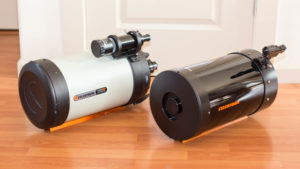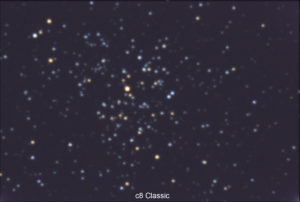c8HD vs c8 Classic EAA and Visual Comparison Review
By: Vlad Fedosov
Intro:
I have had the opportunity to use and test out at least 5 c8’s and 3 different Meade 8” SCT’s over the years. For one reason or another up until now I never came across one of Celestron’s newer EdgeHD scopes. Well, my luck finally changed as I managed to acquire a c8 EdgeHD to evaluate both visually and for EAA. To add to the c8 fun I also had a classic c8 to do a direct comparison with. The EdgeHD series from Celestron is the newest design of SCT that incorporates an optical corrector in the secondary mirror system that corrects for both comma and provides a flat field. So how does this newest and most advanced SCT design stack up to a 20+ year-old c8 that was made in the good ‘ol USA? Let’s find out!

Testing:
Taking advantage of a rare clear evening during the winter I set up the 8” EdgeHD on my g11 mount and proceeded to collimate it. With a bit of a touch-up, I had the scope ready to go with perfect collimation. The thing I was most curious about is how the scope would compare both visually and with a camera in its edge performance compared to the classic c8, since the center of the field of view(FOV) should theoretically be about the same on both the scopes. I chose open cluster m37 for the comparison as it was high overhead and filled the FOV of the scopes nicely.
I started with a visual comparison using an Explore Scientific 24mm 68° FOV eyepiece. Visually the difference between the scopes was quite apparent after a bit of scrutiny. The EdgeHD displayed a very refractor like image with nice round stars right to the edge of the FOV. Switching to the classic c8 I was greeted with a view that was nice but the edge performance was definitely a bit behind the newer scope. Stars towards the edge of the FOV are definitely not as crisp. I will say that this is not a difference that knocked my socks off or anything. It was something that I really needed to look for but it was there. I do believe that the difference it a bit more apparent with the EdgeHD compared to several ACF Meade scopes that I have tried. I also did not note a brighter image in the EdgeHD since it does have the newer XLT coatings. Visualy the newer scope did produce a nicer looking image though!
Moving onto the imaging aspect, I did a comparison 3 min stack of 5-second subs with my ASI 178MC camera. I do not do imaging in the traditional sense but do like electronically assisted astronomy(EAA) for deep sky objects when I’m observing in the city. The 178MC sensor is fairly small, so if you are using a larger sensor you would likely see a more prominent result between the two OTA’s. The Edge HD was mated with a .7x Celestron reducer and the c8 classic was mated with a .63 reducer that’s made for standard SCT’s


As you can see from the images, there is not a heck of a lot of difference in the performance of the two OTA’s when using a smaller sensor camera. The one aspect that a serious astrophotographer will enjoy about the Edge HD scopes is that they do have a mirror lock. You can also install optional fans much easier into the new EdgeHD scopes witch help with cooldown times.
Conclusion:
I guess the question is whether the EdgeHD is worth the 3x price of the c8 classic? Well, that’s a question that you will have to answer for yourself. I think that for someone that is going to use the scope visually and can afford the price difference I would lean towards the Edge HD. If you are a serious astrophotographer with a larger sensor camera I think you will definitely want the newer scope. If you are just using the scope for EAA with a smaller sensor camera I honestly cannot say that the EdgeHD gives you a significant advantage.
Support AVT-ASTRO
If you found this review helpful and are considering purchasing the product that was discusses please concider purchasing this item on Amazon using the link here. I get a small commission from Amazon and it really helps to pay for running this site!
